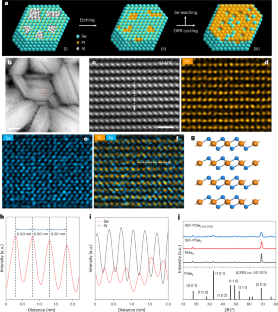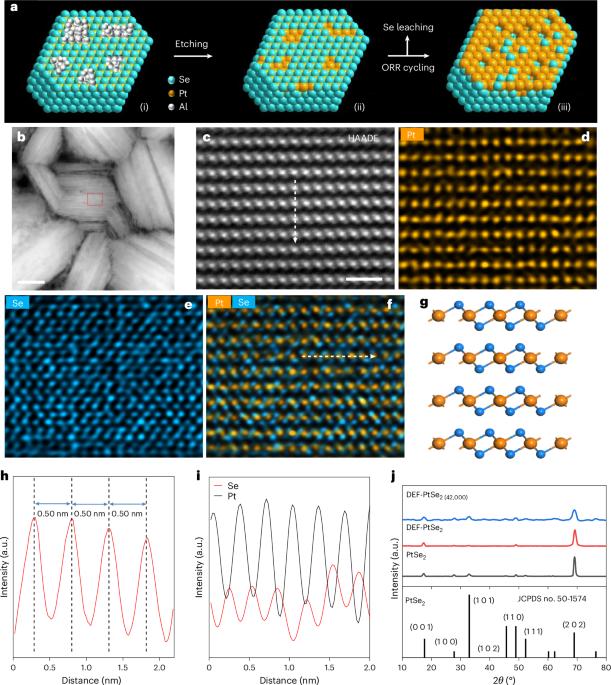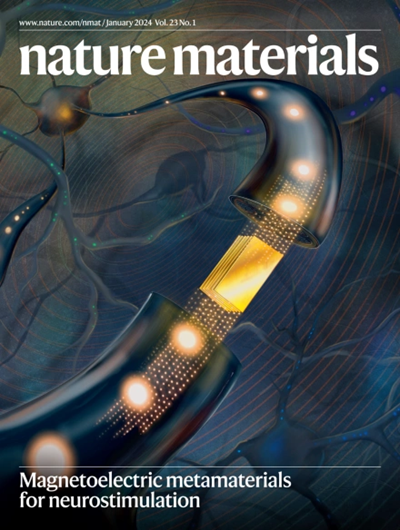反应驱动缺陷硒化铂重组为超稳定氧还原反应催化剂
IF 37.2
1区 材料科学
Q1 CHEMISTRY, PHYSICAL
引用次数: 0
摘要
PtM(M = S、Se、Te)二卤化物具有高空气稳定性、可调带隙和高载流子迁移率,是电子、光电和气体传感器领域前景广阔的二维材料。然而,由于其半导体特性和范德华堆叠产生的有限表面积,它们作为氧还原反应(ORR)电催化剂的潜力往往被低估。在这里,我们展示了一种通过在氧气饱和的电解质中进行电化学循环,重组有缺陷的二硒化铂(DEF-PtSe2),从而合成高效稳定的 ORR 催化剂的方法。与商用 Pt/C 电催化剂相比,经过 42,000 次循环后,DEF-PtSe2 的比活性提高了 1.3 倍,质量活性提高了 2.6 倍。即使在 126,000 次循环后,DEF-PtSe2 仍能保持卓越的 ORR 性能,且衰减极小。利用混合密度泛函理论进行的量子力学计算表明,性能的提高是由于铂纳米颗粒和 DEF-PtSe2 表面顶端活性位点的协同作用。这项工作凸显了 DEF-PtSe2 作为 ORR 持久电催化剂的潜力,为 PtM 二卤化物电化学和先进催化剂的设计提供了启示。本文章由计算机程序翻译,如有差异,请以英文原文为准。


Reaction-driven restructuring of defective PtSe2 into ultrastable catalyst for the oxygen reduction reaction
PtM (M = S, Se, Te) dichalcogenides are promising two-dimensional materials for electronics, optoelectronics and gas sensors due to their high air stability, tunable bandgap and high carrier mobility. However, their potential as electrocatalysts for the oxygen reduction reaction (ORR) is often underestimated due to their semiconducting properties and limited surface area from van der Waals stacking. Here we show an approach for synthesizing a highly efficient and stable ORR catalyst by restructuring defective platinum diselenide (DEF-PtSe2) through electrochemical cycling in an O2-saturated electrolyte. After 42,000 cycles, DEF-PtSe2 exhibited 1.3 times higher specific activity and 2.6 times higher mass activity compared with a commercial Pt/C electrocatalyst. Even after 126,000 cycles, it maintained superior ORR performance with minimal decay. Quantum mechanical calculations using hybrid density functional theory reveal that the improved performance is due to the synergistic contributions from Pt nanoparticles and the apical active sites on the DEF-PtSe2 surface. This work highlights the potential of DEF-PtSe2 as a durable electrocatalyst for ORR, offering insights into PtM dichalcogenide electrochemistry and the design of advanced catalysts. Defective platinum diselenide can serve as a highly efficient and stable catalyst for the oxygen reduction reaction outperforming commercial Pt/C catalysts, which is achieved by a restructuring approach via electrochemical cycling.
求助全文
通过发布文献求助,成功后即可免费获取论文全文。
去求助
来源期刊

Nature Materials
工程技术-材料科学:综合
CiteScore
62.20
自引率
0.70%
发文量
221
审稿时长
3.2 months
期刊介绍:
Nature Materials is a monthly multi-disciplinary journal aimed at bringing together cutting-edge research across the entire spectrum of materials science and engineering. It covers all applied and fundamental aspects of the synthesis/processing, structure/composition, properties, and performance of materials. The journal recognizes that materials research has an increasing impact on classical disciplines such as physics, chemistry, and biology.
Additionally, Nature Materials provides a forum for the development of a common identity among materials scientists and encourages interdisciplinary collaboration. It takes an integrated and balanced approach to all areas of materials research, fostering the exchange of ideas between scientists involved in different disciplines.
Nature Materials is an invaluable resource for scientists in academia and industry who are active in discovering and developing materials and materials-related concepts. It offers engaging and informative papers of exceptional significance and quality, with the aim of influencing the development of society in the future.
 求助内容:
求助内容: 应助结果提醒方式:
应助结果提醒方式:


